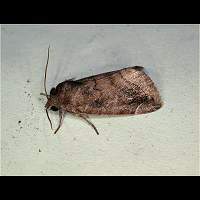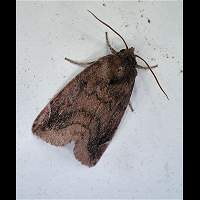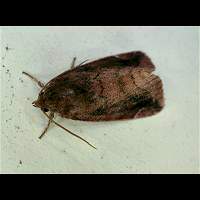Lunar-spotted Pinion Cosmia pyralina
The striking, white spot, shaped like a half moon near the tip of the wing gave the The Lunar-spotted Pinion its name. Often the groundcolour is also a very good characteristic. The wing is warm brown, often with a pinkish glow. In pictures this glow is generally invisible, especially when flash or other artificial lights were used. Another feature of this Pinion is the extensive light patch on the outer edge of the wing. The other Pinions (the White-spotted Pinion and the Lesser-spotted Pinion) are quite similar, but the lines in their wings are whitish and not blackish and the small white spots are not shaped like they were half moons. Some specimens of the highly variable Dun-bar are similar to the Lunar-spotted Pinion too, but the first always lacks the half moon-shaped white spots. So usually you won't have much trouble identifying this species in the field. The wingspan varies from 29 to 34mm, meaning this is quite a small Noctuid.
The Lunar-spotted Pinion deposits her eggs on the foodplant in summer. They don't hatch before April of the next year, though. The caterpillars feed both by day and by night. By the end of May or the beginning of June a cocoon is woven among leaf litter on the ground. Pupation takes place within the cocoon. It takes this species only three to four weeks to pupate. The caterpillar itself is rather short and fat. It is light green, often even yellowish green. There is a yellow, slightly indenting dorsal line. Below it is another, thinner white line. Above the spiracula, which are white, runs another balder whitish line. Furthermore each segment has a few smaller or larger whitish markings, usually circular. The caterpillar will eventually reach a length of 26 to 30mm. It is being seen on various deciduous trees, but prefers elm. It is possible this species will eat other caterpillars should it encounter them. All caterpillars of Cosmia species have a tendency towards cannibalism, even if there is plenty of food at hand. So far however it has only been proven Dun-bar caterpillars eat other caterpillars and even actively hunt them down.
The Lunar-spotted Pinion is single brooded and is on the wing in June and July mainly. It usually flies by night only, but is seen in dusk visiting flowers in gardens from time to time. In gardens it does not just visit flowers, but is also keen on the honeydew produced by Aphids. Is readily attracted to light and sugar. Animals caught during the night can be photographed with ease the next day. Most however refuse to be manipulated. The species is found in light forests, roughs, parks and gardens. Not uncommon in southern Britain. The northern border of its territory runs through Lancashire. The species is also not uncommon on the continent, without being really abundant anywhere.
The striking, white spot, shaped like a half moon near the tip of the wing gave the The Lunar-spotted Pinion its name. Often the groundcolour is also a very good characteristic. The wing is warm brown, often with a pinkish glow. In pictures this glow is generally invisible, especially when flash or other artificial lights were used. Another feature of this Pinion is the extensive light patch on the outer edge of the wing. The other Pinions (the White-spotted Pinion and the Lesser-spotted Pinion) are quite similar, but the lines in their wings are whitish and not blackish and the small white spots are not shaped like they were half moons. Some specimens of the highly variable Dun-bar are similar to the Lunar-spotted Pinion too, but the first always lacks the half moon-shaped white spots. So usually you won't have much trouble identifying this species in the field. The wingspan varies from 29 to 34mm, meaning this is quite a small Noctuid.
The Lunar-spotted Pinion deposits her eggs on the foodplant in summer. They don't hatch before April of the next year, though. The caterpillars feed both by day and by night. By the end of May or the beginning of June a cocoon is woven among leaf litter on the ground. Pupation takes place within the cocoon. It takes this species only three to four weeks to pupate. The caterpillar itself is rather short and fat. It is light green, often even yellowish green. There is a yellow, slightly indenting dorsal line. Below it is another, thinner white line. Above the spiracula, which are white, runs another balder whitish line. Furthermore each segment has a few smaller or larger whitish markings, usually circular. The caterpillar will eventually reach a length of 26 to 30mm. It is being seen on various deciduous trees, but prefers elm. It is possible this species will eat other caterpillars should it encounter them. All caterpillars of Cosmia species have a tendency towards cannibalism, even if there is plenty of food at hand. So far however it has only been proven Dun-bar caterpillars eat other caterpillars and even actively hunt them down.
The Lunar-spotted Pinion is single brooded and is on the wing in June and July mainly. It usually flies by night only, but is seen in dusk visiting flowers in gardens from time to time. In gardens it does not just visit flowers, but is also keen on the honeydew produced by Aphids. Is readily attracted to light and sugar. Animals caught during the night can be photographed with ease the next day. Most however refuse to be manipulated. The species is found in light forests, roughs, parks and gardens. Not uncommon in southern Britain. The northern border of its territory runs through Lancashire. The species is also not uncommon on the continent, without being really abundant anywhere.






